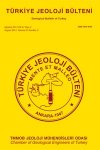
-
2025
-
2024
-
2023
-
2022
-
2021
-
2020
-
2019
-
2018
-
2017
-
2016
-
2015
- 2014
-
2013
-
2012
-
2011
-
2010
-
2009
-
2008
-
2007
-
2006
-
2005
-
2004
-
2003
-
2002
-
2001
-
2000
-
1999
-
1998
-
1997
-
1996
-
1995
-
1994
-
1993
-
1992
-
1991
-
1990
-
1989
-
1988
-
1987
-
1986
-
1985
-
1984
-
1983
-
1982
-
1981
-
1980
-
1979
-
1978
-
1977
-
1976
-
1975
-
1974
-
1973
-
1972
-
1971
-
1970
-
1969
-
1968
-
1966
-
1964
-
1963
-
1961
-
1959
-
1958
-
1955
-
1954
-
1953
-
1952
-
1951
-
1950
-
1949
-
1948
-
1947
View as PDF
Abstract: Biogeochemical characteristsics of Balıkesir-Balya Pb-Zn Mine Waste site, known as the oldest andlargest mine tailing site in Turkey, and its influence on generation of acid mine drainage was investigatedby geochemical, molecular and microbiological approach. The oxidation of sulfide rich rocks and waste,mostly left over from Balya Pb-Zn mining activities, is generating acidic water with low pH (2.7), andcontributing to metal contamination containing up to 1.88 mg/L Pb, 24 mg/L Zn, 2.5 mg/L As ve 17 mg/LCu. Geochemical and molecular/microbiological analysis on mine waste, sediment and water samples(acidic, surface) show that acidic surface waters generated from sulfide weathering are principal pathwaysfor mobility and redistribution of environmentally important elements in the environments. Based oncultivation based microbiological analysis carried out on acidic ponds developed around and in BalyaMine waste sites , the mean acidofilic sulfur oxidizing bacteria (aSOB) and acidophilic iron oxidizingbacteria were determined as 8.4x108cell/ml ve 9.6 x107 cell/ml, respectively.The relatively low values forsurface water of Maden creek, where mine wastes reach, were determined as 3.8 x106 cell/ml ve 5.7x103cell/ml, respectively. Molecular analysis of 16S rDNA gene sequences from acidic sediment and sedimentfrom Maden Creek show the dominance of S and Fe-oxidizing prokaryotes belonging to Acidithiobacillusspp. genus in the primary drainage communities. Relatively small populations of Sulfobacillus spp.werealso determined . Moreover, species belong to Thiobacillus spp.and Thiovirga spp. genus were onlydetermined on the sediment samples from Maden creek with low acidity relative to acidic sediment. Thesesulfur oxidizer indicates a dynamic microbial population which adapt to changing geochemical conditions.Identification of Fe oxidizer and reducer along with Jarosite, plumbojarosite and goethite in the sedimentsof acidic ponds indicate significance of microbial Fe cycle governing mobilization and redistribution ofthe metals in the waste site. Overall, it is shown that microorganisms regulating S and Fe cycle in Balyamine waste site is the key factors controlling generation and chemistry of acidic drainage water.
Abstract: Many geothermal fields in Kütahya including Eynal, Çitgöl ve Naşa (Simav), Ilıcasu-Abide (Gediz),Muratdağı, Yoncalı, Emet, Yeniceköy, Dereli, Göbel, Ilıca (Harlek), Sefaköy ve Hamamköy (Hisarcık) andŞaphane are located between Kütahya and Simav active faults in Western Turkey. Studied area in Simav(Kütahya) is situated in the north of Simav Fault and indicated as an active fault zone in the active faultmaps of Turkey. This area is fairly active region in terms of earthquakes occurred in the instrumental period and has many geothermal systems. Most of these geothermal fields are located on active fault zones.Approximately 735 earthquakes (M>3.0) occurred between May 2010 to May 2013, including 1 earthquake with the magnitude of greater than 6.0 at Gediz in 1970 and 4 earthquakes with the magnitude ofgreater than 5.0 at Simav in 2009, 2011 and 2012. Data from a monitoring study during three years (2010-2013) from thermal springs in Eynal, Çitgöl ve Naşa geothermal fields which located at Simav (Kütahya)were used in this study. This study tried to find out relationship between geothermal springs and activefaults, and relationship between hydrochemical features of geothermal waters and high seismic activity.The results of this study indicated that some physic-chemical parameters of geothermal waters change especially increasing temperature, increasing Cl- ion value and decreasing SO4-2 ion value with earthquakeswith has 5.0 and greater magnitude value.
Abstract: Çameli Basin is located on the middle of the Burdur-Fethiye Shear Zone (BFSZ) which is tectonicallya very active region in southwestern Anatolia. This region is one of the locations on BFSZ which hasextensive young sediments.BFSZ is an active shear zone which is located between the eastern Aegean extensional province,the Hellenic Arc and the Isparta Angle. Its length is about 310 km and its average width is 40 km. It ischaracterized by the Middle Miocene-Quaternary aged NE-SW-trending faults and basins. One of theseintermontane basins is the Çameli Basin.Jurassic-Cretaceous aged ophiolites, recrystallized limestones and partly clastic rocks, which areknown as Lycian Nappes, and the Eosen aged turbidites, which cover them unconformably, compose thebasement of the Çameli Basin. The Middle-Lower Miocene aged Gölhisar Formation consists of meanderand braided river deposits that are conglomerate, sandstone, claystone and shalestone and locatedunconformably on this basement. Gölhisar Formation shows lateral and vertical transition to UpperMiocene-Lower Pliocene aged İbecik Formation. İbecik Formation is a lacustrine environment unit thatconsists of clay, sandy limestone, marl, clayey limestone and thick bedded limestones. Upper PlioceneLower Quaternary aged alluvial fan deposits composed of conglomerate, mudstone, silt and clay overlieuncomformably on İbecik Formation. Recent alluvium deposits settled uncomformably on this unit that isnamed the Dirmil Formation.The recent tectonic activity on the region shows that the region is under the influence of NE-SWand almost N-S extension. When considering the fault plane solutions of the earthquakes and small andlarge scale faults, NE-SW-trending left lateral and left lateral oblique normal faults and almost N-Etrending normal faults indicate a typical left lateral shear regime. Also, NE-SW, NW-SE and almost N-Strending left lateral oblique normal and normal faults in the Miocene aged sediments are evidence of theshear and rotation on the region.The evolution of Çameli Basin began with a predominant compressional regime in the EarlyMiocene and proceeded with a left lateral movement in the Middle-Late Miocene. The basin is still situatedwithin a Pliocene-Recent aged left lateral extensional regime.

 TMMOB
TMMOB